
If the last two years in financial markets were a movie, they’d be a mix of The Wolf of Wall Street (euphoria), Final Destination (impending doom), and Groundhog Day (rates are still high, but stocks keep going up?!). Investors have enjoyed substantial gains in stocks, Bitcoin, and gold. Yet the fear and greed index says that investors are “fearful.”
I believe rising Treasury yields, sticky inflation, and a cocktail of economic and political risks make 2025 a year when caution should be the default setting, and I am repositioning my portfolio accordingly.
Market Performance: The Good, the Bad, and the Overpriced
The money supply: M2
Yes, it surged from 2019-2022, driving inflation and asset prices THEN.
However, I think it’s foolish oversimplification (and likely wrong) to attribute asset price growth from 2023-2025 to a general increase in the money supply NOW.
- January 2023 M2: $21,187 ($ billions of dollars)
- January 2025 M2: $21,533
- Change: +1.6%
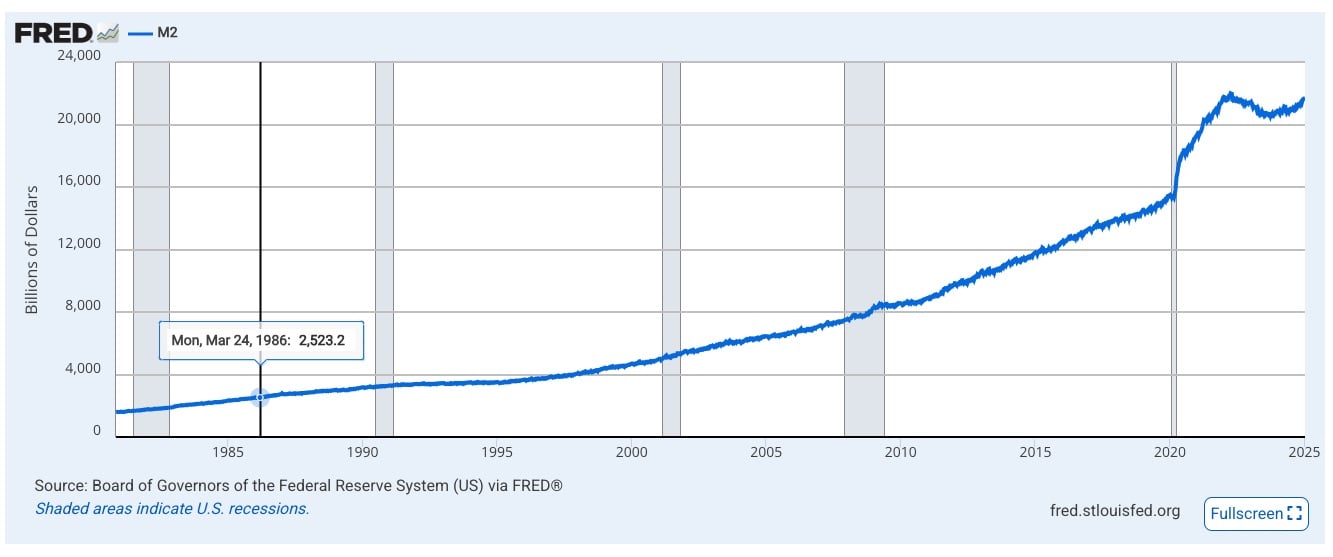
M2 is a proxy for the money supply that attempts to measure most short-term liquidity positions, including money in bank accounts, currency, and other liquid deposits, like money market accounts.
Contrary to the party line of a large horde of fiat critics out there, the money supply is not increasing at a faster rate than asset values or inflation in the last two years.
There is no doubt in my mind that the 39% increase in the money supply from 2019 to 2022 was a major driver of inflation and the surge in asset prices. I am skeptical, however, that inflation since 2023, for both the CPI and asset values, has been primarily a result of an increase in the money supply. From 2023 onwards, I believe that other factors have been at play—like the long-term trend of baby boomers leaving the workforce, resulting in wage growth.
In 2025, I believe that the story will shift, at least in Q1 and Q2. Prices are increasing because of something other than the money supply right now. Investors should take that seriously.
“The government keeps printing money” is/was a great sound bite/diagnosis for price increases when you are the 900th comment on a pro-Bitcoin Reddit thread. And it was a correct observation and a real reason to believe in major inflation from 2020 through 2022.
But that surge in the money supply, I believe, has already been largely absorbed into the economy and was reflected in the prices of goods, services, many wages, real estate, and stocks by the middle of 2022.
I’d be careful as an investor—dollars in savings accounts may not degrade in real value over the next five years at anywhere close to the rate they did from 2019-2022.
S&P 500: U.S. stocks are priced for a golden age, where everything goes perfectly according to plan for the biggest companies in the world.
- January 2023: 3,999
- January 2025: 6,040
- Change: +51%
The S&P is as expensive as it’s ever been, relative to earnings, aside from 1999/2000. With the Shiller P/E ratio at 38.5X, the only other time it’s been this expensive relative to trailing 10-year earnings was in 1999. It’s risen 2.35X in six years, from 2,600 in January 2019.
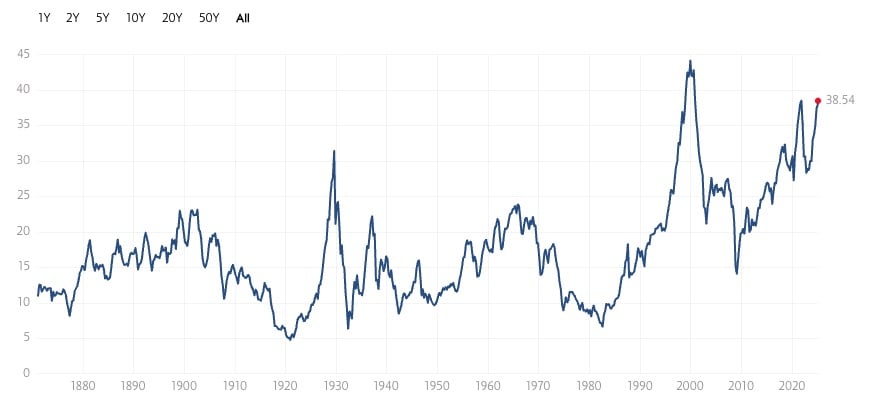
This time is different, right? Artificial intelligence (AI), American hegemony, globalization, inflation, deregulation with a new “pro-business” administration, strong earnings growth, etc., will all drive an unprecedented wave of corporate profits, right?
If you are invested in the S&P 500, that’s the bet. I don’t like that bet.
I believe that this is the riskiest stock market since 1999, and a lot of people who buy into the “the stock market always goes up in the long run” argument could be hurt badly.
Therefore, I am reallocating away from stocks to bonds and real estate.
Bitcoin: Same price-to-earnings ratio, different price
- January 2023: $17,000
- January 2025: $96,000
- Change: +465%
Remember when Bitcoin was “dead” in 2022? Well, turns out it was just taking a power nap. BTC is back with a vengeance, largely fueled by institutional adoption, ETF approvals, and the ongoing distrust in traditional fiat currencies. That being said, with this level of parabolic growth, any major shock (say, a regulatory crackdown) could lead to an ugly unwind.
I believe that, per my observation about the money supply, Bitcoin’s price surge from 2023 to 2025 is not a result of the dollar losing value but rather the result of a surge in speculative demand.
I am extremely unpopular and seemingly nearly alone with this take, but I worry that in the event of a recession or market crash that requires people to begin harvesting portions of their portfolios, Bitcoin can and will get hit first and hardest.
This is an “asset” that is still, in my view, at risk of total loss at any time. Growth in price is not a sign of worldwide adoption, but of ever-increasing, geometrically compounding risk.
I own no Bitcoin. To head off the Bitcoin people who will immediately chime in and tell me how I am missing out on an asset that would “make my bloodline” (actual comment from Bitcoin Bro) and what an expensive position they think I hold, here is a rendering of me in 10 years, per ChatGPT, after missing out on Bitcoin’s takeover:

Gold: Slow and steady, store of value—except it’s rising in price almost as fast as the S&P 500
- January 2023: $1,850/oz
- January 2025: $2,650/oz
- Change: +43%
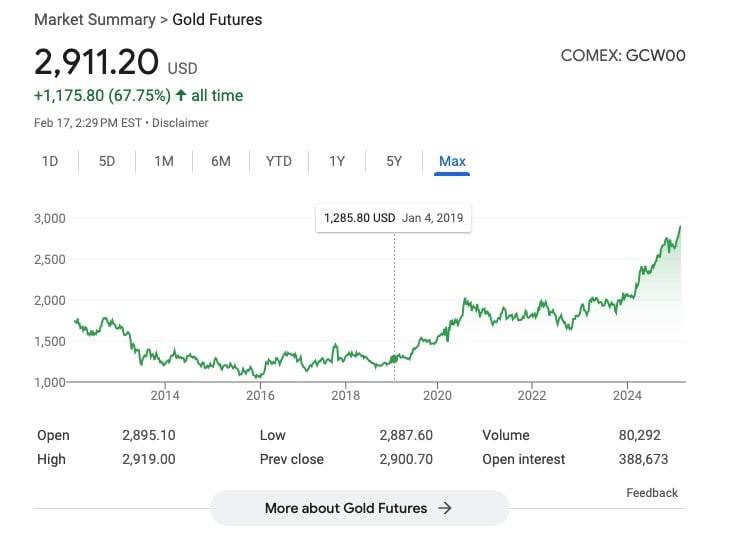
In January 2019, gold traded at $1,285/ounce. That’s a 2.2X increase against a 40% increase in the money supply. Gold’s rise in an era of high interest rates is like a tortoise winning the race—it’s slow but inevitable. Or at least, this is why investors, speculators, or the scared tend to flee to gold.
But what is gold when its value accretes almost as fast as the S&P 500 during a historic bull run? Is it really a safe haven and hedge against inflation?
Given gold’s price run-up, I wonder if people are paying for security or just FOMO. I own no gold.
Residential real estate: The forgotten stepchild
- January 2023 Case-Shiller National Home Price Index: 298
- January 2025: 314
- Change: +5.3%
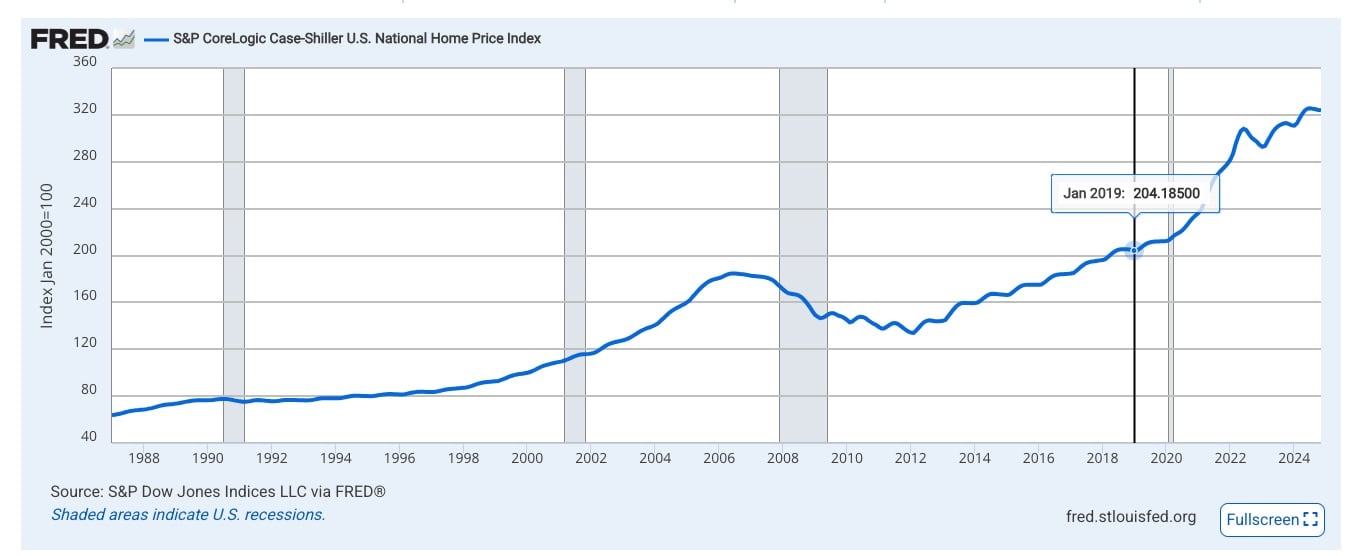
Unlike stocks and Bitcoin, real estate has been the designated driver at this financial party. High mortgage rates have kept housing prices from surging, and while single-family homes have held up better, commercial real estate (CRE) has been a different story.
Back in January 2019, the Case-Shiller index traded at 204. Or put differently, housing prices have risen 53% in six years. Without leverage, this asset class has been one of the worst performers of the last five to seven years, and housing—single-family homes, specifically—has been the best-performing part of the real estate ecosystem, with asset values getting crushed from 2022 to the present in many commercial real estate sectors.
Residential real estate has seen price and rent growth only marginally outpace growth in the money supply in the last few years. I believe it is at a much lower risk than other asset classes in 2025. Therefore, I am conservatively buying real estate with funds reallocated from stock holdings.
Commercial real estate: Deep, soul-crushing, generational wealth-destroying, and possibly career-ending pain for investors over the past six years
- January 2023 Green Street Commercial Property Price Index: 154
- January 2025: 127
- Change: -18%
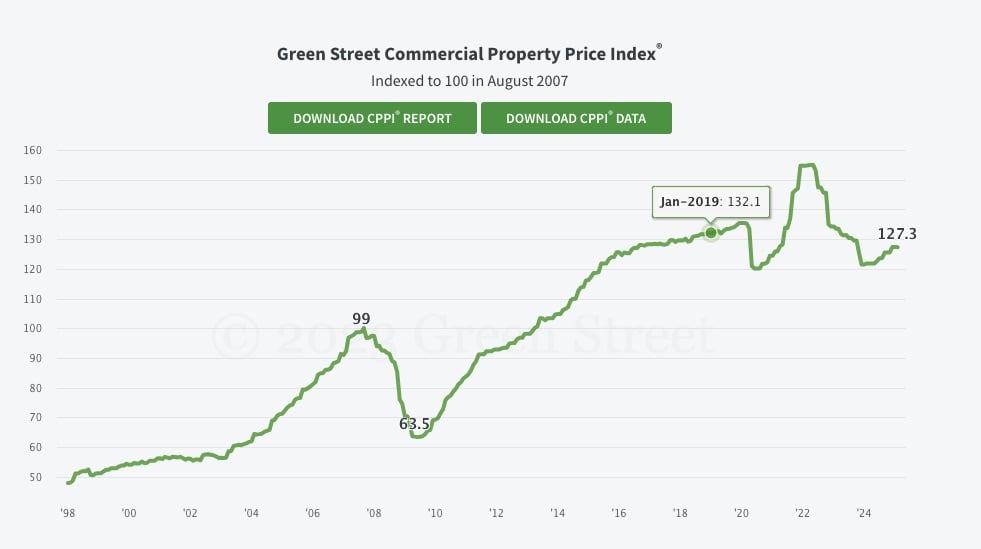
This is ugly. And it’s not like CRE investors who got in at 2019 price levels enjoyed a high enough run-up to still be sitting pretty on large gains in 2025. In six years, commercial real estate has lost 4% of its value, led by deep pain in the office sector from 2019 to the present and deep pain in multifamily from 2022 to the present.
When we consider how commercial real estate is one of the most highly leveraged asset classes out there, an 18% decline can mean equity losses of 40% to 60% for investors.
2025 is shaping up to be the year the chickens come home to roost in multifamily: The supply onslaught continues, there seems to be no end in sight to falling interest rates, demand is not high enough to drive meaningful rent growth, operating expenses continue to rise, and a material percentage of the debt backing these assets matures, forcing horrible refinance or sale decisions.
I’ve been talking about the risks in multifamily specifically for years, with great detail on the risks for 2023 and 2024 spelled out here and here.
I believe that commercial real estate is at, or nearing, the bottom of a historically bad cycle.
I am watching the CRE market extremely closely, and believe there is a real probability of “no-brainers in 2H 2025.” My “residential” investment was actually a quadplex, which is in between a “commercial” and “residential” property.
As I study the market more, I think there is a reasonable probability that I buy a lot of CRE in the next two years.
The Two Areas of Commercial Real Estate I’m Most Curious About
1. Multifamily is likely at or close to the bottom in many regions
If it’s not already “buy time” in multifamily/apartments, it will be by 2H 2025, or certainly 1H 2026.
Whatever we have been waiting for in terms of a buying opportunity in multifamily is likely to be here right now or months, not years, away. I’ve never seen a bid/ask spread as high in my career, and I think that a lot of influencers-turned-syndicators who bought at the peak from 2021-2022 will be forced to realize massive losses this year and next.
Their pain is the conservative investor’s gain. I think that in five years, few who buy in 1H 2025 will feel like they bought anywhere close to the top, and it’s very possible that right now is the bottom for this asset class. I am starting to buy now, conservatively, with light or no leverage, and will likely continue to buy, adding leverage if things get worse and worse.
I love Denver and think the pressure on sellers is very real here right now, but I think that markets like Austin, Texas, and most major Florida markets are likely to be some of the best values in the country.
2. Office space: Is it currently priced for the apocalypse?
I recently talked to an investor who bought a 12-cap office building with a current occupancy of 72%, seller-financed at 70% LTV for five years with interest-only debt, at a 40% lower valuation than its last sale in 2013. Either he exits that thing at an eight-cap in five years, with 90%+ occupancy, or South Denver dies as we know it.
Is office so beaten-down and depressed as an asset class that buying an office building has become an “Either people come back to work here in the next three to seven years, or this part of the city will decay and turn to dust” bet?
You can bet I will become a student of the office market in 2025, in the same way, that I have attempted to become a student of single-family and multifamily these past 10 years. I am currently a novice in understanding office real estate, so I merely pose the question of whether this is the right time.
10-Year Treasury Yield: Rising Like a Persistent Villain
- January 2023: 3.5%
- January 2025: 4.9%
- Change: +40%
Bond yields have continued their steady climb, leaving anyone hoping for a Fed pivot sorely disappointed. Higher yields mean borrowing costs remain elevated, which should put downward pressure on everything from stocks to home prices.
Again, higher Treasury yields should put downward pressure on everything from stocks to home prices. They haven’t had this effect in the last two years, outside residential real estate, which has seen little to no growth in the last two years, and commercial real estate, which has crashed.
Bonds: No Respect From a Generation of Investors Who Haven’t Experienced a Downturn
- January 2023 Vanguard Total Bond Market ETF (VBTLX) Price: $9.66
- January 2025 VBTLX Price: $9.55
- Change: -1%
As interest rates rise, bond equity values fall. Interest rates fell nearly continuously from 1982 to 2022:
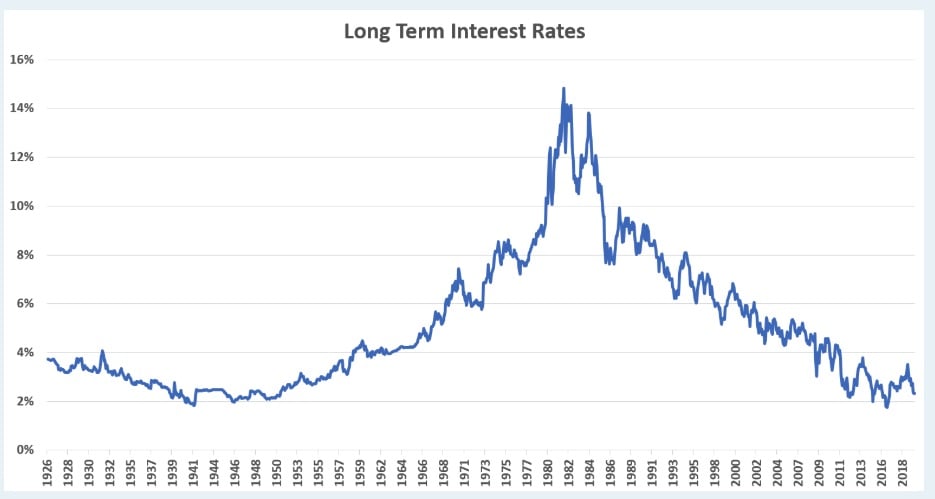
Bonds do very well in that kind of environment and, better, also serve their intended purpose as a hedge against a market downturn—in the event the market crashes or there is a deep recession or depression, investors can expect the Federal Reserve to lower interest rates, which props up bond equity values for investors.
In recent years, many investors, at least those who frequent BiggerPockets, seem to be exiting bonds. It makes sense on the surface. Bond yields are still too low (VBTLX currently offers a measly 4.6% yield to maturity and even less in income—a smart shopper can get 3.8% to 4.2% on a good savings or money market account with a lower risk of principal loss and extremely high liquidity) to really make sense.
But good times make investors forget that these bonds are what can save a portfolio, including a traditional or early retirement, in the event of a severe downturn. Falling rates result in equity gains for bonds, and a downturn is highly likely to coincide with quick rate drops from the Fed.
I am considering, but have not yet done so, moving my retirement account positions to be in the 60/40 or 50/50 stocks/bonds allocation.
What Am I Doing in Response to All This?
In an environment where markets are frothy, risk is high, and uncertainty is everywhere, I believe the logical investor response includes:
Trimming stock exposure + rebalancing/reallocating
With stocks at near-all-time high price-to-earnings ratios, I felt that the prudent move was to reset my portfolio. I rebalanced and moved a huge portion of my stock portfolio to lightly levered real estate in Q1 2025.
Holding more cash
A hefty cash position provides dry powder for when the inevitable pullback arrives. I always maintain a larger-than-usual cash position because I feel it would be highly embarrassing to declare personal bankruptcy after writing a book called Set for Life. So, no real change here.
Investing in debt + bonds
With Treasury yields approaching 5%, bonds and real estate-backed loans offer compelling risk-adjusted returns. In addition to potentially rebalancing some of my portfolio to a 60/40 or 50/50 stocks/bonds position, I will likely add a hard money loan or two back to my portfolio this year if I don’t buy more real estate outright. As a semiprofessional real estate investor, I feel that my ability to foreclose on real property greatly reduces my risk on private loans in the category.
Buying residential real estate
Lightly levered, or completely paid off: High rates mean borrowing is expensive. If you’re buying real estate, paying cash (or at least limiting leverage) can help mitigate risk. The cap rate on my most recent purchase is extremely close, after tax, to the yield I can get on a short-duration hard money note. If I can yield ~10% (7% cap rate + 3% appreciation on average) on an asset that should see price and rent growth, hold pace with or grow in value faster than inflation without using any debt at all, why bother overthinking it?)
Studying and training myself to spot “no-brainers” in commercial real estate, specifically multifamily and office
I think there is a reasonable probability that an incredible buyer’s market is here, right now, in office, and just around the corner, in multifamily. I don’t know what I’m doing in office. That will change. I intend to study, maintain access to liquidity, and be ready to enter this space with a meaningful part of my portfolio in the next 18 months.
On Taxes and the Realization of Gains
I frequently hear investors argue that making moves like those I list is incredibly tax-inefficient—or at least they observe that I will pay taxes. A major portfolio reallocation can absolutely create tax drag.
I have a unique perspective on taxes that I think is worth mentioning, as it informs my decision-making.
First, I optimize for post-tax net worth, usable in my life today, right now, not pre-tax net worth at traditional retirement age or time of death.
I am 34 years old. Maximizing the value of my estate to pass on incrementally more wealth to my heirs some 50 years down the road is meaningless. Unless I do something extremely risky, and blow everything, there should be plenty for my heirs later in life.
My two-year-old daughter is not thinking about an extra million dollars when she is 55. She is thinking about playing hide-and-seek with me today. The opportunity cost of traditional tax minimization advice that could lead to me not having cash flow or liquidity to optimize time with her right now will cost me much more than even a several hundred-thousand-dollar tax hit.
My wealth, my true wealth, is the after-tax liquidity my portfolio can generate for me today. Not a number with eight figures on it 30 years from now in my spreadsheet.
Second, I am willing to bet that capital gains taxes will go up in the future. While it is more efficient to simply allow wealth to compound in perpetuity tax efficiently, never harvesting gains, there is every chance that the marginal tax rates for capital gains will increase in the future. In fact, I will (and in some ways, already am) bet(ting) on it. This lessens the wealth consequences of paying taxes on gains now.
There is also the real, though remote, possibility that tax brackets for capital gains increase so much over my lifetime that I am actually ahead by paying taxes at today’s rates rather than those of the 2055s.
Third, I only realize gains when I have personal use for the proceeds or I am reallocating dollars.
If I believe that I will incur less risk or have a shot at better returns, the tax consequences are much lower. I believe that the moves I make, when I make them infrequently and realize gains, are likely to provide much more upside, or much less risk, than keeping assets in place; otherwise, I won’t make them.
If I’m right, the tax drag is a nonfactor. If I’m wrong, I’ll see a double hit (tax drag AND worse returns, compared to leaving things be), but I will at least sleep better at night.
Fourth, specific to 2025, real estate offers serious tax advantages. For some individuals, real estate losses can offset gains in other asset classes. This can be a huge boon. I can access these losses with a specific type of investment (listing a property as a short-term rental) that I am considering for 2H 2025.
Final Thoughts
2025 is shaping up to be a year when investors need to tread carefully. The market’s relentless optimism in the face of high rates and geopolitical uncertainty is concerning to me. Whether it’s an overvalued stock market, a speculative Bitcoin rally, or still real concerns in commercial real estate, despite my speculation that we are nearing a bottom, risks are everywhere.
They say investors have two emotions: fear and greed. My analysis screams “fear,” and that’s exactly what I feel, by and large, as we head into 2025.
Please disagree, laugh at me, get angry with me, or do the digital equivalent of giving me a “you should know better than to attempt to analyze the market” in the comments. And then, make an example of me over the next few years.
I am sure to be wrong, categorically, on multiple points, or possibly every point, now that I’ve committed my thoughts to writing, published them, and acted on them.
I deserve the scorn of any pundit, the opportunity cost of my actions, and the tax consequences. But, I can’t help but share my analysis, thoughts, and fears with this community. It’s what I think. It’s what I feel. It’s what I’m doing.
Please do push back on any part of this analysis that you disagree with—starting with my observations about the money supply (M2), which are sure to ruffle some feathers.
I’d love links to other datasets that challenge my viewpoints or understanding of the money supply more broadly. This seems to be a central point where many investors and the market have a different view than I do.
Source link





